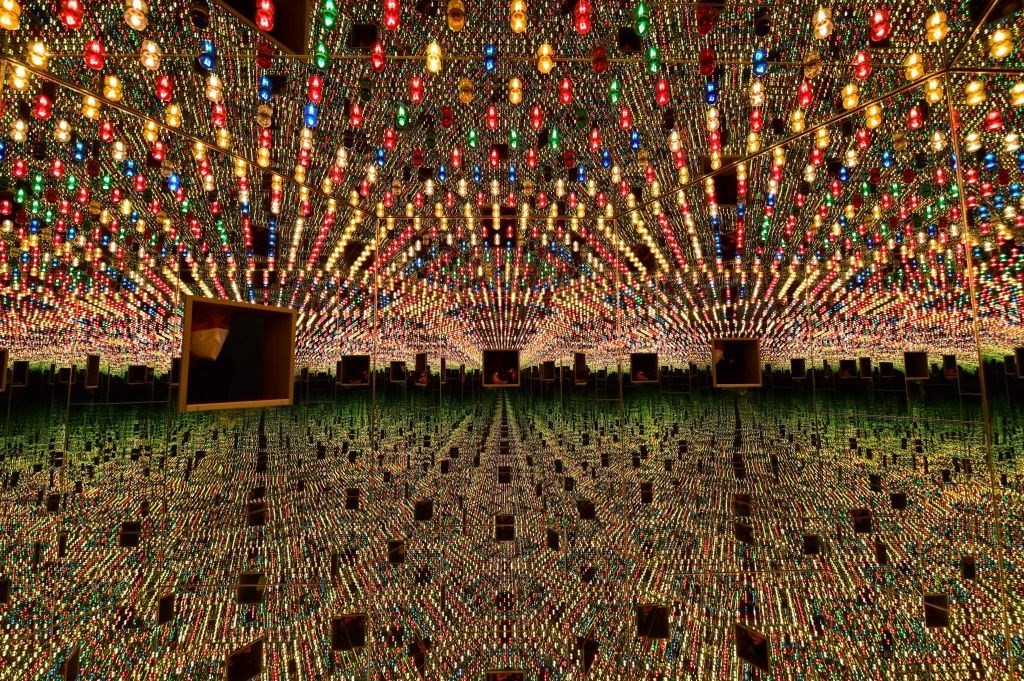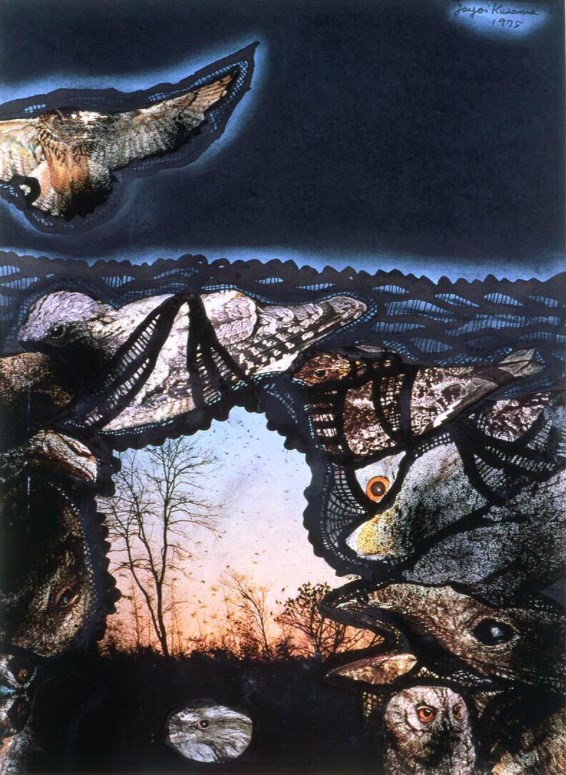After achieving success in New York in the 1970s, the artist moved back to Japan after a series of mental breakdowns and suicide attempts
“Swallow antidepressants and it will be gone. Tear down the gate of hallucination. Amidst the agony of flowers, the present never ends. At the stairs to heaven, my heart expires with tenderness. Calling from the sky, doubtless, transparent in its shade of blue.”
In 1978, Japanese artist Yayoi Kusama penned a book of poetry on her experiences battling depression during the time she lived in New York. As hinted in the title, Manhattan Suicide Addict references the two times Kusama, under the intense pressure of being an emerging artist stigmatised by her race and gender in New York, attempted to take her life. Through artistic expression, she was able to rise from the ashes of her depression and the prejudice that stifled her to become one of the world’s most successful living artists.
Among the endless infinity nets and mirrored rooms, it’s easy to be totally distracted by Kusama’s deserved success. But it’s within the artist’s lost years that we are reminded of the importance of recognising the opposite of this, and the value that failure – or, at least, perceived failure – brings to understanding art.
“Amidst the agony of flowers, the present never ends” – Yayoi Kusama
In the early 1970s, Kusama returned to Japan after living for 14 years in New York, where she started her career from scratch: a pivotal time which, while characterised by ‘failure’, defined the future of her entire career. This unknown, yet critical moment in her trajectory has recently been bought to life by the recently released documentary from Heather Lenz, Kusama – Infinity.
The focus on these years in the film are critical in that they allow us to recognise – and emphasise – the art world’s inherent prejudices which set marginalised artists up to fail, while also reminding us that success doesn’t solely define an artist. Above all, Kusama’s failures show us the brave struggle she had to endure to reach the success she has today – while her male counterparts climbed towards it with ease, often ripping her off in the process.
In celebration of the film’s release, take a trip through time and trace Yayoi Kusama’s lost years, and the struggles she faced on the way to becoming one of the world’s most famed artists.
KUSAMA’S COPYCAT MEN, 1962
After living in New York for four years, in 1962, Yayoi Kusama made one of her most famous sculptures, “Accumulation No.1” in a downtown loft located in the same building as the studio of artist Claes Oldenburg. A sofa was the first in a set of three sculptures that uses phallic shaped mini soft sculptures to form the shape of a domestic product whose design and use of a phallus was an overt statement of feminism. The works are also said to be a release of Kusama’s childhood trauma.
At the time, however, working in male-dominated New York and coming off the back of America’s 1950s domestic conservatism, Kusama’s phallic sculptures were glazed over by the art world. Male critics ignored their obvious symbolism, while her friend Oldenburg seemingly stole her design. Kusama showed “Accumulation No.1” in a group show with Oldenburg, who arrived with a set of soft sculpture creations. “If you looked around the show, it was all soft sculpture,” Kusama explains to the camera in Kusama – Infinity. “But no one was doing soft sculpture at the time. Then his wife came over to me and said ‘Yayoi, I’m sorry’.” Kusama still claims that “Accumulation” was the biggest inspiration for Oldenburg’s subsequent soft sculptures, but while Kusama received no recognition, Oldenburg shot to fame. This made Kusama depressed.
Sadly, Oldenburg wasn’t the only one appropriating Kusama’s work. In 1964, Andy Warhol, already famed for his pop art, attended Kusama’s solo exhibition, Aggregation: One Thousand Boats Show, at the Gertrude Stein Gallery. She presented a rowboat covered in phallic soft-sculptures, which she took a photo of, and papered the entire space with a replicated image in an attempt to immerse her viewers in infinity. ‘Wow, fantastic Yayoi! I like this so much’”, Kusama recalls Warhol saying, as she explains the situation in Infinity. “That influenced him, and then he had a show. He covered the walls with images of a cow. When I saw it, I was surprised. Andy picked up what I did and copied it in his show.” Kusama became suspicious of her fellow artists, and, in order to create, covered up all the windows to her studio.
In the late 1960s, people became more conscious of infinity as America found itself obsessed with sending man to the moon, and interest in space soared. Kusama caught onto this and developed one of the first gallery installations to use mirrors in her 1965 “Infinity Mirror Room: Phalli’s Field”. A year later, she presented her Kusama’s Peep Show, also known as her Endless Love Show, at the Castellane Gallery in New York and cemented herself as a pioneer mirror artist. The work featured a small rectangle hole where viewers could peer into a space of flashing coloured light bulbs, similar to New York’s infamous Broadway lights. In the same year, artist Lucas Samaras introduced a totally new direction in his work by creating a walk-in mirrored installation at New York’s Pace Gallery. Kusama was making work of equal, if not more, importance, but wasn’t getting the same recognition because of the blatant sexism and racism at hand, both of which played a part in her depression.

KUSAMA AS AN ARTIST UNDER RICHARD NIXON’S REIGN, 1969
In the mid-1960s, Kusama started to organise naked protests as a resistance of the Vietnam War. Being a child of war herself (Kusama had to spend time as a teen making parachutes for the Japanese army) she staged naked body painting in public settings, as well as group orgies. “I made my art to try and change peoples’ minds about the love in the world that can last forever,” Kusama explains in Infinity. “I wanted to spread hope to the world through my artwork.”
In 1968, Kusama penned a letter to Richard Nixon inviting him to participate in an orgy. Titled “An Open Letter to My Hero, Richard M. Nixon”, the letter wrote: “Our earth is like one little polka dot, among millions of other celestial bodies, one orb full of hatred and strife amid the peaceful, silent spheres. Let’s you and I change all that and make this world a new Garden of Eden… You can’t eradicate violence by using more violence.” While not expecting a reply from Nixon, Kusama went on to host a “Nixon orgy”, where she offered erotic services in return for a ceasefire in Vietnam.
“I made my art to try and change peoples’ minds about the love in the world that can last forever” – Yayoi Kusama
What Kusama could not have predicted is that a year later, when Richard Nixon became president, life would shift hugely for artists on the margins. From the start of his term in 1969, American politics was no longer driven by war but was used to target America’s countercultural movements including feminism, queerness, and foreignness. This, in turn, further perpetuated a world where white straight male artists could excel, while creatives who were pushing boundaries in the name of counterculture found it harder to find a place to work and to function artistically and economically. Kusama, who was a marginal figure as a Japanese woman, did not get the same support that her male counterparts did. Job titles such as critic, curator, and museum directors were also heavily dominated by white men, which further marginalised Kusama. The respect she had earned in the early 1960s had been largely diffused by America’s conservative political context, so the artist became disillusioned and further depressed. When Kusama wrote Manhattan Suicide Addict in 1978, it was this era of her life she was referring to, as the bleak sorrow of the poetry hints at Kusama’s suffering under the weight of the US.

RETURNING TO JAPAN, TOKYO, 1973
After the death of her friend and once partner, painter Joseph Cornell, and depleted by the depression of her declining career in New York, Kusama relocated to Tokyo in 1973. Having lived in America for over a decade, Kusama was not recognised as an artist in Japan, so she was forced to start her career from scratch. “I felt that Japan was a hundred years behind the US,” Kusama tells the camera in Infinity. “When I returned to Japan, they treated me like a very scandalous presence. All the journalists were very backwards and they wanted to portray me in a negative way.”
In 1974, Kusama lost her father, which triggered a string of traumatic experiences from her childhood. Suffering from the rejection of the Japanese art world and lack of support from her family, her life in the early 1970s became a bitter experience. It was at this time that she turned her attention to new mediums like ceramics, watercolours, pastels, collage, and a started writing poetry. “It was as if an invisible curtain rolled down,” Kusama says in the film. “I felt separated from my surroundings. And then I was drawing. The drawing would expand out of the canvas to fill the floor, and when I looked in the distance, I would see hallucinations, and I would get surrounded by that vision. Because my childhood memories were traumatic, I became very depressed and I couldn't paint anymore. And then, I tried to commit suicide.”
FINDING PEACE AT THE SEIWA HOSPITAL, 1975
Since Kusama was a child, art has been her greatest form of mental release. “By translating hallucinations and fear of hallucinations into paintings, I have been trying to cure my disease,” Kusama explains in Infinity. This was definitely the case in 1975 when Kusama found a hospital that offered art therapy and checked herself in after another attempted suicide in 1974. From the stability and artistic expression offered in this space, Kusama began to rebuild herself. In the Seiwa Hospital, the artist turned to collage as her main mode of expression, and here she made some of her most well-known collages, in which intricate symbolism offers a psychosomatic reading of Kusama’s mind. Take “Soul Going Back to Its Home” (1975) as a key example. The Joseph Cornell tribute piece features different types of animals like birds and fish collaged over an image that shows a troupe of birds flying to the heavens at sunset. The sense of peace conjured by the image not only references an artist searching for mental liberation but a freeing of her relations to Cornell as she grapples with the grief of his death. In March 1977, Kusama became a permanent resident at Seiwa hospital, and she bought a studio nearby. She still lives and works at both spaces today.
“By translating hallucinations and fear of hallucinations into paintings, I have been trying to cure my disease” – Yayoi Kusama
KUSAMA’S UPWARD SOAR, FUJI GALLERY, 1982
For Kusama’s lost years, art was the biggest form of therapy and a large force in the artist’s reappraisal, which started with a key show at Tokyo’s Fuji Gallery in 1982. Before Fuji, Kusama began to show her collages at the first space she ever had a show, the First Community Centre in Matsumoto, where she showed 250 of her earliest works in 1952. In this sense, she came full circle to begin her career again. Kusama’s Fuji show, Obsession Yayoi Kusama, was the first show in Japan to exhibition Kusama’s paintings and sculptures, drawing on 30 works from the 1950s-60s. Hearing about the show, curator Alexandra Munroe flew over to Tokyo, and after attending the exhibition, she knew she had to display Kusama’s work in New York again – and she made it her mission. A spark was suddenly lit in Kusama’s work. In 1989, she revisited Kusama, collected old ephemera, publicity, and paintings to take back to New York. Because of the explicit content of Kusama’s work, Munroe was stopped at customs because they thought she was bringing in pornography. She had to explain it was art.

RESURGING WITH A NEW YORK RETROSPECTIVE, 1989
With all of the collected material, Kusama had her first New York retrospective in 1989 at the Centre for International Contemporary Arts. Yayoi Kusama: A Retrospective signified a major revival of American and European interest in the artist’s work, and it was the first time she had shown in the US in over 16 years. Parallelling this revival was a revaluation of her work in Japan, and in the same year, Kusama became the first ever Japanese artist to grace the cover of Art in America.
BREAKING THE 45TH VENICE BIENNALE, 1993
Continuing to reappraise herself as an artist by breaking art records around the globe, in 1993 Kusama was invited to exhibit her work at the 45th Venice Biennale, making her the first Japanese woman to ever show at the esteemed event. Traditionally, Japanese artists would show in groups of two or three, but in honour of Kusama’s strong personality and talent, she was given a solo show, also making her the first Japanese artist in the history of the Biennale to exhibit alone.
For her submission, Kusama drew on critical works early works from the 1950s, as well as sculptures from the 1980s. She also created and performed alongside “Mirror Room (Pumpkin)”, featured below. As an artist who once crashed the Biennale with 1500 silver balls in her famed “Narcissus Garden” (1966), to become the first Japanese woman to show, and have a solo exhibition at the Biennale signified Kusama’s resurgence from her lost years.
BRINGING HOME THE CROWN, MATSUMOTO: 2002
Despite her resurgence in the western world and being chosen to represent her country at the Biennale, back home in Japan, Kusama was still largely resisted. This was until the Matsumoto City Art Gallery was built. In 2002, the space held a Kusama retrospective, uniting over 280 of the artist’s works, and drawing huge floods of Matsumoto residents. This not only sparked important Japanese interest in Kusama, but it also cemented Kusama’s position as one of Japanese art history’s most important revolutionaries. “I was finally able to bring the crown home,” Kusama stated at the reception to the show, to which people almost wept in response.
As Lynn Zelevansky, curator of Love Forever: Yayoi Kusama, 1958-68 (1998), beautifully reflects on Kusama's lost years at the end of Infinity: “Overall her trauma made her withdraw, but what she has always done, she has always angled that process incredibly well. There’s a managing madness about Kusama which is so utterly sane. She has used her trauma to incredibly productive ends.”
You can find out more about Kusama – Infinity here

